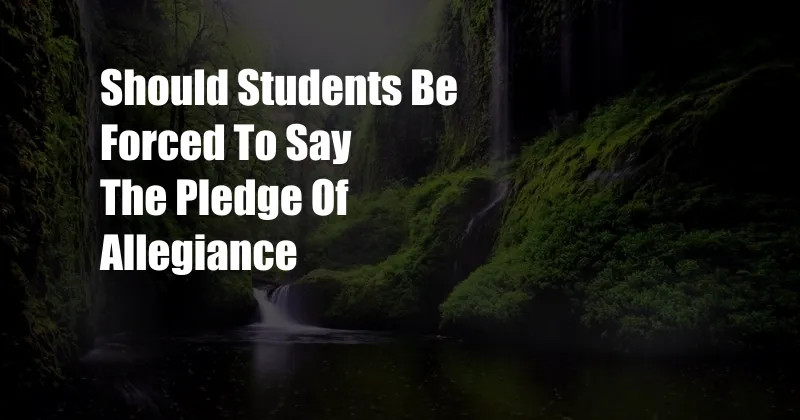
Should Students Be Forced to Say the Pledge of Allegiance?
I remember being in elementary school and standing up every morning to say the Pledge of Allegiance. I didn’t really think about it. It was just something that we were supposed to do.
But as I got older, I started to wonder why we were saying the Pledge of Allegiance. What did it mean? Was it really necessary? In this blog post, we will explore the history of the Pledge of Allegiance, its meaning, and the arguments for and against requiring students to say it.
The Pledge of Allegiance: A History
The Pledge of Allegiance was written in 1892 by Francis Bellamy, a minister and socialist. Bellamy was inspired to write the pledge after attending a Fourth of July celebration in 1889. He wanted to create a patriotic statement that would be recited by schoolchildren across the country.
The Pledge of Allegiance was first published in the magazine Youth’s Companion in September 1892. It quickly became popular in schools, and by 1942, it had been adopted by Congress as the official pledge of allegiance for the United States.
The Meaning of the Pledge of Allegiance
The Pledge of Allegiance is a simple statement of patriotism. It expresses our love for our country and our commitment to its values. The pledge also reminds us of the sacrifices that have been made by those who have fought for our freedom.
The first line of the pledge, “I pledge allegiance to the flag of the United States of America,” is a promise to be loyal to our country. The second line, “and to the republic for which it stands,” is a reference to the American ideals of democracy and freedom. The third line, “one nation under God, indivisible, with liberty and justice for all,” is a statement of our belief in the importance of unity, equality, and justice.
The Arguments for and Against Requiring Students to Say the Pledge of Allegiance
There are several arguments in favor of requiring students to say the Pledge of Allegiance. First, it is a way to instill patriotism in young people. When students recite the pledge, they are reminded of the values that our country was founded on. This can help to create a sense of national unity and pride.
Second, the Pledge of Allegiance is a way to teach students about the history of our country. The pledge mentions the flag, the republic, and the principles of liberty and justice. By reciting the pledge, students can learn about the important events and ideas that have shaped our nation.
However, there are also several arguments against requiring students to say the Pledge of Allegiance. First, some people argue that it is a violation of the First Amendment. The First Amendment guarantees the freedom of speech, and some people believe that reciting the Pledge of Allegiance is a form of government-sponsored speech that violates this freedom.
Second, some people argue that the Pledge of Allegiance is not inclusive. The pledge includes the phrase “under God,” which some people believe is offensive to non-believers. Additionally, the pledge does not mention the contributions of women and minorities to the United States.
Tips and Expert Advice
If you are a teacher or a parent, there are several things you can do to help students understand the Pledge of Allegiance. First, you can explain the history of the pledge and its meaning. Second, you can help students to think critically about the pledge and the values that it expresses.
Third, you can provide students with opportunities to learn about the contributions of women and minorities to the United States. This will help students to see that the pledge is not inclusive and that it does not reflect the diversity of our country.
FAQ
Q: Is it legal to require students to say the Pledge of Allegiance?
A: Yes, it is legal to require students to say the Pledge of Allegiance. The Supreme Court has ruled that the Pledge of Allegiance is not a form of government-sponsored speech and that it does not violate the First Amendment.
Q: What should I do if my child refuses to say the Pledge of Allegiance?
A: If your child refuses to say the Pledge of Allegiance, you should talk to them about their reasons. You can explain the history of the pledge and its meaning, and you can help them to think critically about the pledge and the values that it expresses. You can also provide them with opportunities to learn about the contributions of women and minorities to the United States.
Conclusion
The Pledge of Allegiance is a patriotic statement that expresses our love for our country and our commitment to its values. It is a simple statement, but it has a powerful meaning. The pledge reminds us of the sacrifices that have been made by those who have fought for our freedom, and it inspires us to be better citizens.
Whether or not students should be required to say the Pledge of Allegiance is a complex issue with no easy answers. There are strong arguments on both sides of the issue. Ultimately, the decision of whether or not to require students to say the Pledge of Allegiance is a decision that must be made by each individual school district.
I would like to know what you think. Do you think that students should be required to say the Pledge of Allegiance? Let me know in the comments section below.